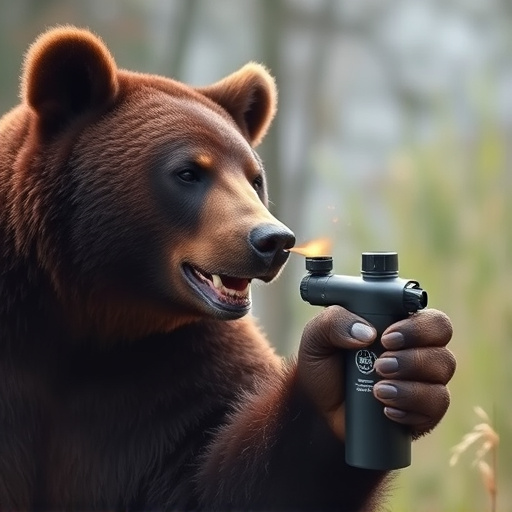Grizzly bears require hikers to understand their behavior for self-defense. Maintain a safe distance (100 yards or 91 meters), make noise, and carry bear spray with high capsaicin concentration (20-30 feet or 6-9 meters range) aimed at eyes, nose, and mouth for maximum deterrence during encounters. Use consistent pressure bursts, remain calm, and back away slowly as last resort.
In the vast wilderness, encountering a grizzly bear can be a terrifying prospect. Understanding these formidable creatures’ behavior and preparing accordingly is vital for adventurers and outdoor enthusiasts. This article equips readers with essential knowledge on navigating close encounters, focusing on the optimal distance for deploying bear spray—a powerful tool in defense. We explore effective application techniques, the latest research on grizzly behavior, and how to choose the right bear spray for maximum effectiveness against these majestic yet potentially dangerous beasts.
- Understanding Grizzly Bear Behavior and Patterns
- Choosing the Right Bear Spray for Maximum Effectiveness
- Application Techniques: Ensuring Bear Spray's Success
- Navigating Close Encounters: Optimal Distance and Safety Measures
Understanding Grizzly Bear Behavior and Patterns
Grizzly bears, known for their immense strength and unpredictable nature, often inhabit remote wilderness areas. Understanding their behavior is crucial for hikers and campers to defend themselves effectively. These majestic creatures primarily feed on plants, berries, and fish but may also become aggressive if they feel threatened or are protecting their cubs. Knowing the optimal distance for bear spray—typically around 20-30 feet (6-9 meters)—is a vital defense mechanism.
By recognizing patterns such as frequent sightings in certain areas during specific seasons, individuals can better anticipate and avoid potential encounters. Grizzly bears usually avoid humans unless they perceive a threat or are curious. Maintaining a safe distance, making noise to deter them, and carrying bear spray are essential precautions when venturing into their habitat.
Choosing the Right Bear Spray for Maximum Effectiveness
When preparing for a potential encounter with a charging grizzly bear, selecting the right bear spray is paramount. Not all bear sprays are created equal; effectiveness depends on factors like canister size, concentration, and spray pattern. Look for products with a high concentration of capsaicin, the active ingredient responsible for numbing the bear’s senses. The optimal distance for bear spray use is between 20 to 30 feet (6 to 9 meters), though this can vary based on wind conditions and the bear’s behavior. At this range, you want the spray to reach the bear’s eyes, nose, and mouth, causing it to pause and retreat.
Consider factors like the spray’s reach and the number of bursts per canister. Canisters with a wider spray pattern and multiple bursts offer better coverage, increasing your chances of deterring an aggressive bear. Always familiarize yourself with the product’s instructions before heading into the wilderness, ensuring you understand how to deploy it effectively in case of an emergency.
Application Techniques: Ensuring Bear Spray's Success
When using bear spray as a defense against charging grizzly bears, understanding application techniques and the optimal distance is crucial. For maximum effectiveness, aim for the bear’s face and eyes from a distance of 20 to 30 feet (6 to 9 meters). This range allows you to deploy the spray in a way that covers the bear’s sensitive areas without blowing it back onto yourself. Practice making quick, even bursts of pressure as you pull the trigger, ensuring complete coverage. Remember, bearing spray is meant for deterrence, not killing the bear. A successful deployment should create enough disorientation and discomfort to allow you to escape.
After spraying, maintain your distance and observe the bear’s reaction. If it continues to advance, repeat the process if necessary. It’s important to note that grizzly bears have a thick fur coat which can reduce the spray’s effectiveness, so be prepared to use it multiple times in close succession. In any encounter, prioritize staying calm, backing away slowly, and only using bear spray as a last resort.
Navigating Close Encounters: Optimal Distance and Safety Measures
When encountering a grizzly bear in the wild, understanding the optimal distance and safety measures is crucial. It’s recommended to maintain a distance of at least 100 yards (or around 91 meters) from bears, as this provides a safe buffer zone for both you and the animal. Keeping this distance allows you to observe the bear’s behavior without causing it undue stress or triggering an aggressive response.
The use of bear spray is also a vital safety measure, especially when closing the gap to capture a better view or take photographs. The optimal distance for deploying bear spray is typically around 25-30 feet (or roughly 7.6-9 meters). This range ensures that you can effectively deter the bear without putting yourself too close. Always carry bear spray, know how to use it, and ensure it’s easily accessible during your wilderness adventures.
When navigating the wilderness, especially in areas known for grizzly bear populations, understanding their behavior and utilizing the right tools are key to safety. Bear spray has proven to be an effective deterrent when used correctly, ensuring you maintain the optimal distance for bear spray application. By following the strategies outlined in this article—from recognizing bear patterns to mastering spray techniques—you can enhance your chances of staying safe during close encounters with these powerful animals. Remember, knowledge and preparation are your best defenses in grizzly country.
